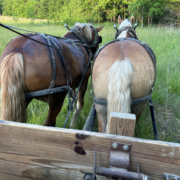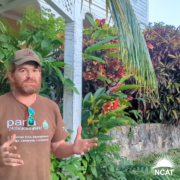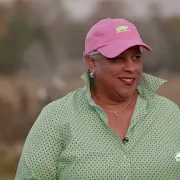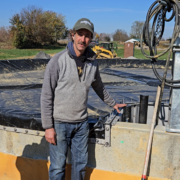Adopting Water-Smart Practices in the Rio Grande Valley
 Print This Post
Print This Post
By Katelyn Amador, University of Texas Rio Grande Valley
The Hub of Prosperity is an urban 5-acre farm managed by sustainable agriculture students like me at the University of Texas Rio Grande Valley in Edinburg, Texas. At the Hub, alongside UTRGV classmates, coworkers, and community members, we dive deeper into building a sustainable food system in the Rio Grande Valley. Water conservation in an area as hot and dry as the Rio Grande Valley can be tough, especially when it comes to irrigation. The Hub of Prosperity ventures into different water conservation methods with a 3,000-gallon rainwater harvest tank and drip irrigation. This large water tank is connected to a rain gutter and aids in the collection of rainwater that can be used to water the farm’s crops. Experimenting with water conservation practices at the UTRGV Agroecology Garden and the Hub of Prosperity farm helps our community understand the importance of implementing water conservation projects.
A key point that is discussed in our tours of the farm and with community garden members is why we use drip irrigation. There are many forms of irrigation, the most common being drip irrigation, sprinkler irrigation, and flood irrigation. Drip irrigation distributes water through plastic tubing that contains spaced-out emitters, which drip water slowly and directly onto the soil directly to the plant root zone. Drip irrigation is effective because of its water-saving ability compared to other methods of irrigation that use more water than necessary. According to NCAT’s The Irrigator’s Pocket Guide, microirrigation helps retain 85-95% of water to the root zone.
In the Rio Grande Valley, flood irrigation, or simply waiting for it to rain, is much more common than drip irrigation. The use of drip irrigation on a large-scale farm can become very difficult very quickly when it comes to affordability, set-up time, and plastic longevity.
As the size of a farm increases, choosing an irrigation method becomes more complex. Not only does the size of the farm matter, but access to water, budget, and environmental impacts also contribute to irrigation method choice. How must our farmers gain maximum efficiency in watering crops when they are so limited in the number of resources that are available?
Converting the irrigation method of a farm can be stressful, especially when the farm has used another irrigation method for a long time. If a farm wants to implement drip irrigation but does not know where to start, the USDA-NRCS provides a program called EQIP (Environmental Quality Incentives Program). EQIP can help farms financially and technically to implement drip irrigation to replace the former method of irrigation. This program helps farms make the switch from a less efficient irrigation method to drip irrigation and funds it for the sake of natural resource conservation. Financial and technical support through NRCS programs and conservation demonstration sites like the Hub of Prosperity can help ease the process of adopting more water-smart practices and guide our region into a more water-conscious and sustainable future.
Related ATTRA Resources:
The Texas Irrigator’s Pocket Guide
Energy Saving Tips for Irrigators
Maintaining Irrigation Pumps, Motors, and Engines
Sustainable Irrigation: A Beginner’s Guide
Other Resources:












